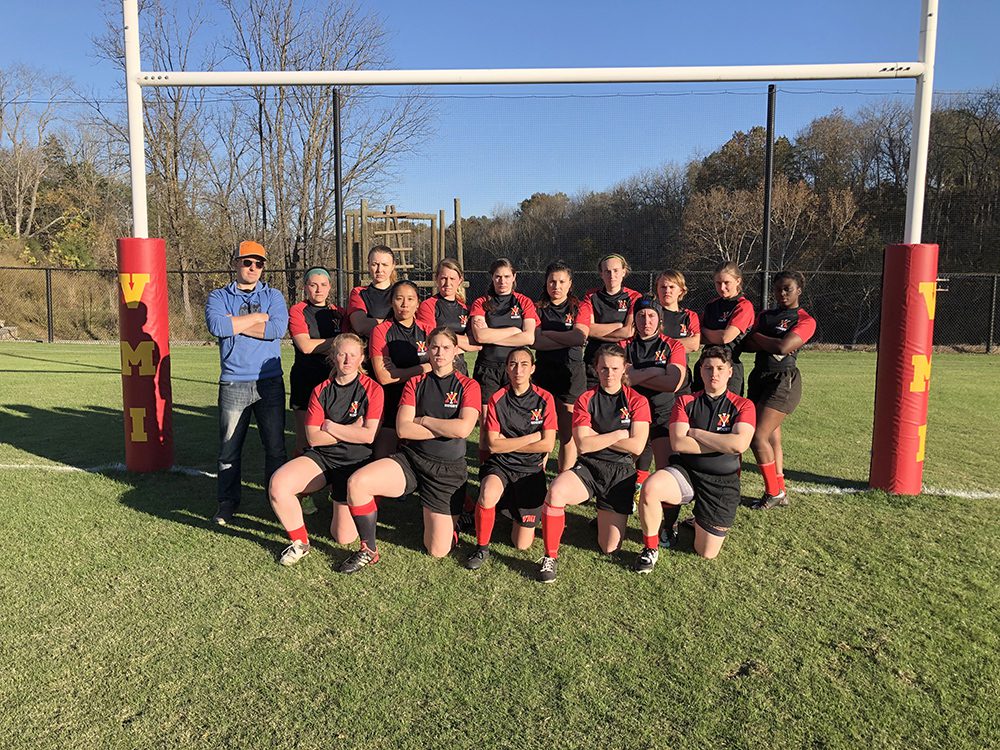Author’s Note: For non-rugby enthusiasts, a brief definition of rugby terms is included at the end of this article.
What is possibly the most successful fall club sport team is also the team that – from the outside looking in – had the least chances of being successful.
The team recruits from an extremely small pool, the entire roster seldom practices together and most players come to the team – and sometimes the games – with little to no experience playing the sport. Adding to the strikes against the team is history: Four years ago, the team had been disbanded due to lack of interest. Despite perceived obstacles, the VMI’s women’s rugby club did not lose a conference match all season – and beat non-conference opponent The Citadel, as well.
The men’s and women’s rugby teams are part of the same organization, explained Capt. Blair Turner, who coaches the women’s side. “This year, the women are the pride of the club, going undefeated in a series of round-robin sevens tournaments around the state,” he said. Rugby can be played in several configurations, with teams of seven or 15 being the most common.
The women’s success comes from many angles: Support received from inside and outside the club, physical fitness and a true team environment. The support for the current women’s success began within the club nearly four years ago.
“When I came here we didn’t have a women’s team,” said Cadet Maddy Moger ’20, team captain. “I walked onto the guys’ team and they let me play with them and practice with them until we built up the women’s team.”
“Support amongst the two teams has always been positive. They practice on the same days and on the same pitch and root for each other on game day,” noted Turner. The two teams also scrimmage each other in practices, Moger said. This helps new recruits to see and feel what a game will be like, and practicing with the men’s side increases training intensity.
Current players explain to potential recruits that “rugby is a sport for everyone. It’s a sport for every body type and ability.” The sport needs a mix of larger, stronger players and smaller, more agile players: No matter what a woman looks like, there’s a position for her on the rugby pitch. Many potential recruits shy away from rugby because they don’t have experience, but Moger explains, “You don’t need experience. We accept everybody. We’ll teach you the sport.”
Explanations aside, recruiting VMI women to play rugby is a challenge that boils down to numbers. Women make up less than 20% of the Corps, meaning there’s not that many of them to actually recruit. This already small group of cadets is heavily involved in Corps activities. The team added a third practice – Wednesday evenings – to give players who are cadre or involved in conducting rat training a chance to get on the pitch.
“Time is a precious commodity at the VMI – club sports must fight for it like everyone else,” said Turner. “Often, if cadets have other commitments, they have to miss practice time.”
Building a winning team has helped recruiting. By the time Moger returned as a 3rd Class cadet, there was enough interest for a women’s team. The newly-rebuilt team went to the Todd Miller Tournament at Longwood University that spring – and won every game. “The majority of the girls had never played in rugby game before and we won the whole thing,” Moger said. “Doing something like that definitely boosts the popularity of the sport.”
Rugby is a rough-and-tumble sport by any account: The full tackles of American football, combined with the constant running of soccer plus some hockey-style roughness, no substitutions unless for an injury – and players wear mouth guards as their only protection.
At VMI, however, this attracts recruits: “I think it appeals to VMI girls a little bit more – the aggressiveness and brutality,” Moger said. “That’s not something that VMI girls easily shy away from.”
Another element of the team’s current success is cohesion. Perhaps built through the shared cadet experience, and definitely helped by the above-average physical fitness gained from Corps life, this team atmosphere serves the ruggers well on the pitch.
“One thing that gives us an edge up is that our girls are fit. Compared to other teams we have so much more endurance and we outlast them on the field,” Moger said. “VMI girls are very quick learners. When we’re in our practices we may not realize that, but it all comes together on the pitch.”
The team also shares in racking up game scores. A wide variety of players score tries during most games. Almost every tournament this season has seen a player “scoring her first try,” Moger said. Most other teams have a couple of “glory hounds” who score most of the tries, but on the VMI women’s side, tries are scored by all positions and all class years.
This fall, the team roster boasts strong contingent of 1st Class and 3rd Class cadets. The younger players are critically important to the continuity of women’s rugby at VMI, while the 1st Class cadets bring experience and leadership. Going forward, the team hopes to add current rats to the team for the spring season, eventually expanding the roster to make playing 15s a regular possibility.
Rugby terms:
7s: Rugby game played with seven players.
10s: Rugby game played with 10 players.
15s: Rugby game played with 15 players.
Try or tries: Method of scoring in rugby; similar to a touchdown in American football. Worth five points.
Pitch: The field on which rugby games are played.





